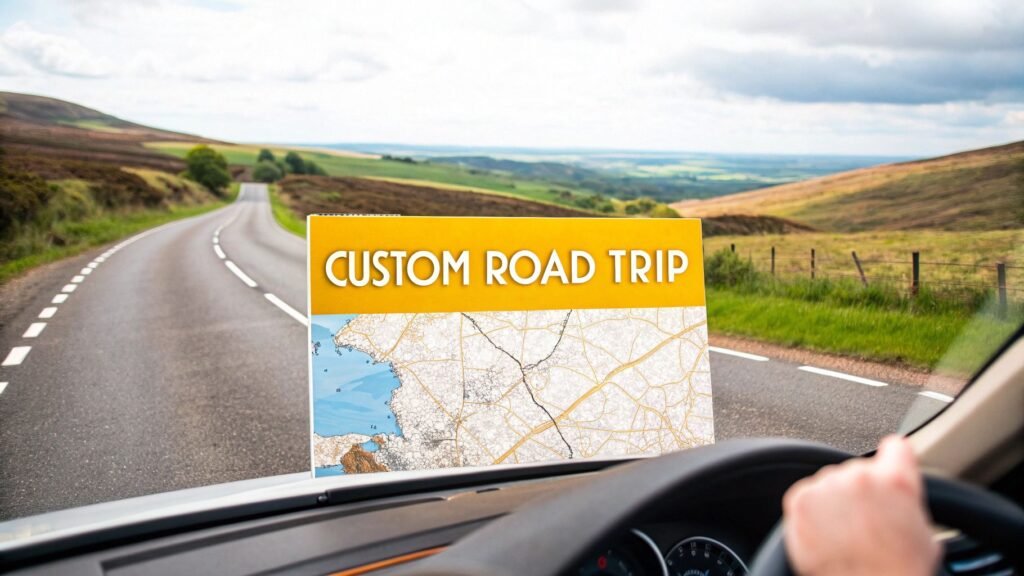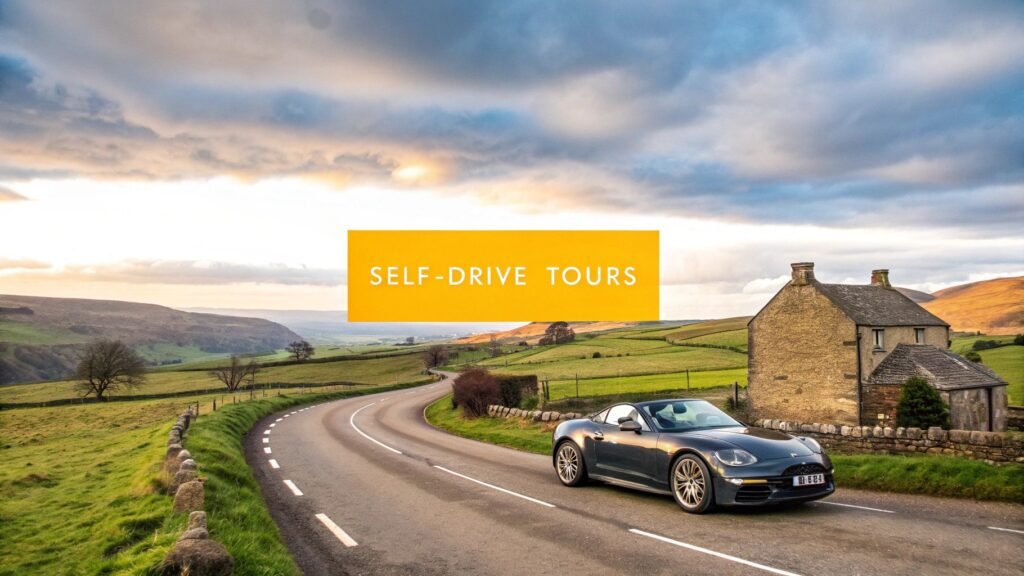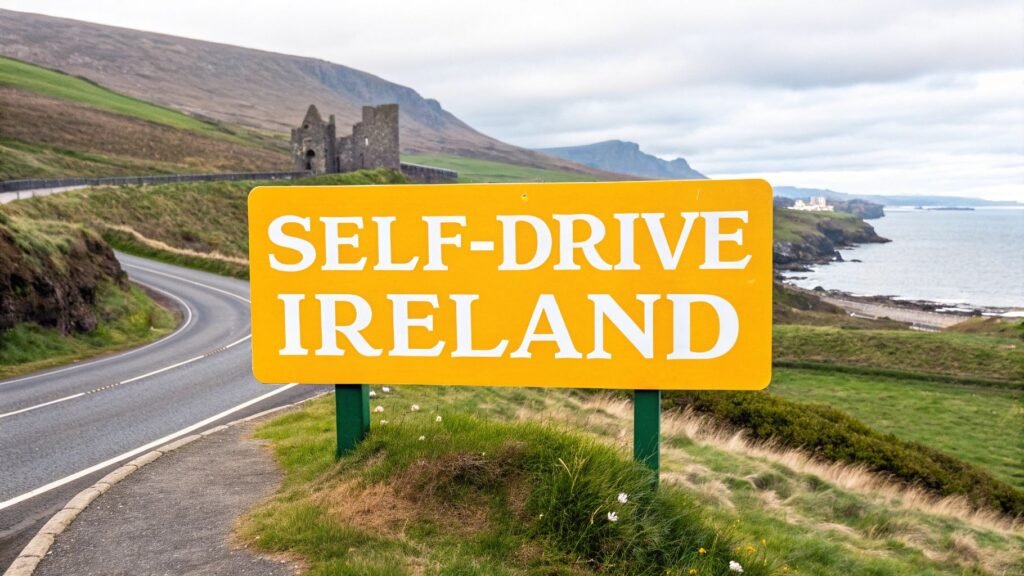Forget those rigid, off-the-shelf tour packages. True custom travel planning is the art of building your adventure from the ground up. It’s about making sure every detail—from the route you drive to the activities you choose—is a perfect match for your personal interests, budget, and, most importantly, your preferred pace.
You’re essentially swapping a one-size-fits-all holiday for an experience that feels like it was made just for you.
The Real Value of Personalised Adventure Planning
There's a definite shift happening in how we travel. More and more people are moving away from pre-packaged holidays and taking the reins themselves. This is especially true in the UK, where the desire for unique experiences and smarter budgeting is changing how people plan their getaways.
Recent travel research highlights this perfectly. Over 50% of British travellers now organise their own trips, though a notable 18% still see the value in getting expert help for the more complicated bits. You can dive deeper into these trends in the TGM Travel Insights report.
This hands-on approach puts you in the driver's seat—both literally and figuratively. It’s the freedom to linger an extra hour at that captivating castle ruin, take a spontaneous detour down a winding country lane, or even skip a planned museum visit for a lazy afternoon in a village pub. That’s the magic of a self-drive tour.
Your Journey's Core Phases
At its heart, crafting your own adventure isn’t as daunting as it might sound. The process breaks down into a few manageable stages, starting with a bit of soul-searching about what you really want from a holiday and ending with a detailed—yet flexible—daily guide. The aim isn't to lock you into a strict schedule, but to build a reliable framework that still leaves plenty of room for those wonderful, unplanned moments.
To give you a clearer picture, this planning process generally follows the flow shown below.
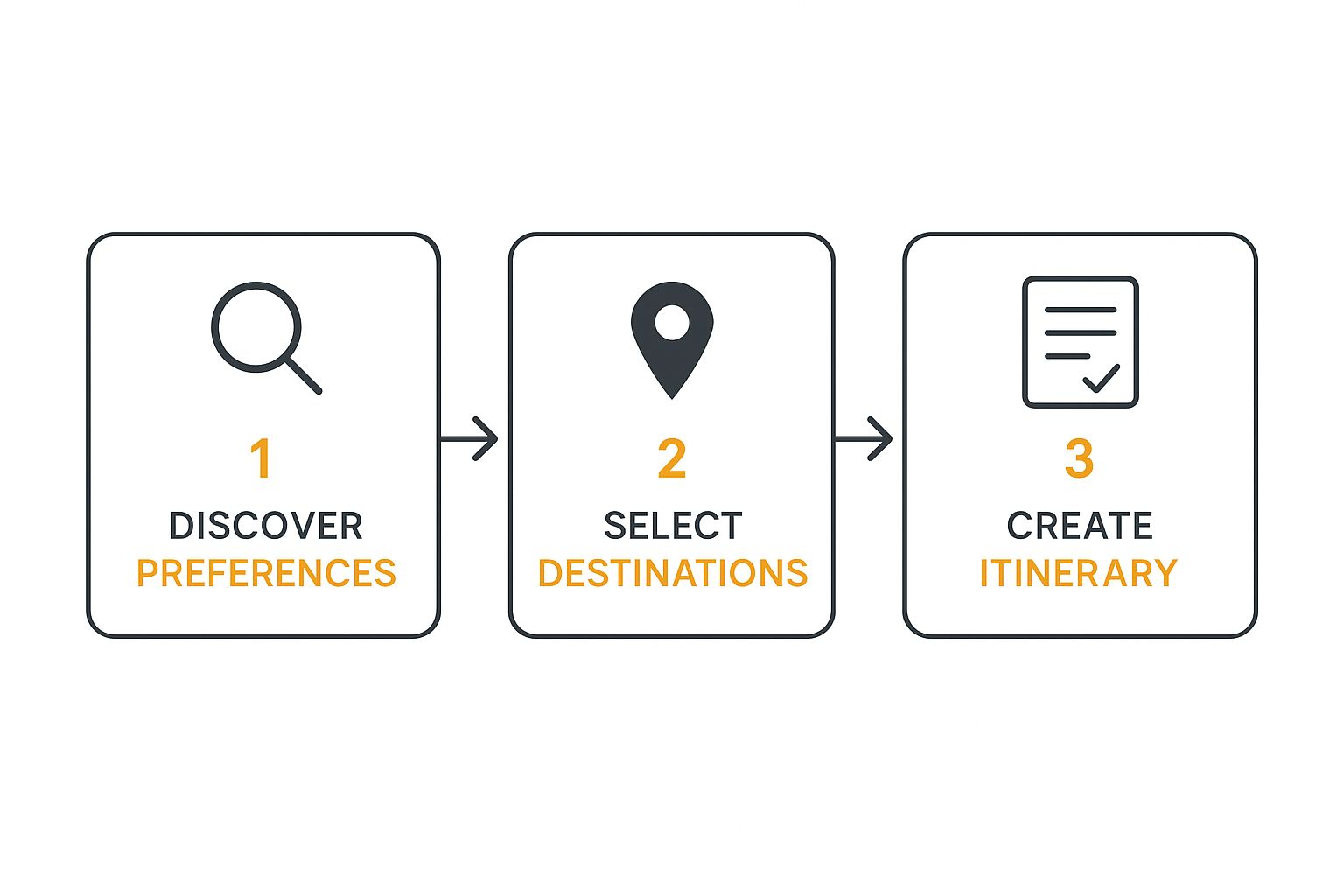
As you can see, a truly great trip starts with understanding your own travel style before you even think about destinations or daily itineraries.
Here's a simple table that summarises the key stages involved in planning your own multi-day self-drive holiday.
Core Phases of Custom Self-Drive Tour Planning
| Planning Phase | Key Objective | Example Activity |
|---|---|---|
| 1. Self-Discovery | Defining your travel style, interests, and non-negotiables. | Listing your top three "must-do" activities (e.g., hiking, visiting castles, food markets). |
| 2. Research & Logistics | Finding destinations that match your style and handling the practicalities. | Comparing car hire options and mapping out potential driving times between key locations. |
| 3. Itinerary Crafting | Building a day-by-day plan that balances activities with downtime. | Creating a daily schedule with one main attraction and a couple of flexible, optional stops. |
This process ensures your trip is built on a solid foundation, turning what could be a standard holiday into a personal story. Instead of just following someone else’s idea of a perfect trip, you become the architect of your own adventure.
By taking control of the planning, you ensure your time and money are invested in experiences that genuinely excite you, leading to a more fulfilling and rewarding journey.
Think about it. A history buff could design a route that connects ancient Roman ruins with medieval battlefields—something a standard tour would likely just glance at. For inspiration, you could spend a week exploring historic counties with our dedicated guide on self-drive tours in England.
Or, if you’re a foodie, you could plan your trip around farmers' markets, famous local restaurants, and hidden culinary gems. This deep level of personalisation is precisely what makes a custom-planned trip so unforgettable.
Laying the Groundwork for Your Ideal Road Trip
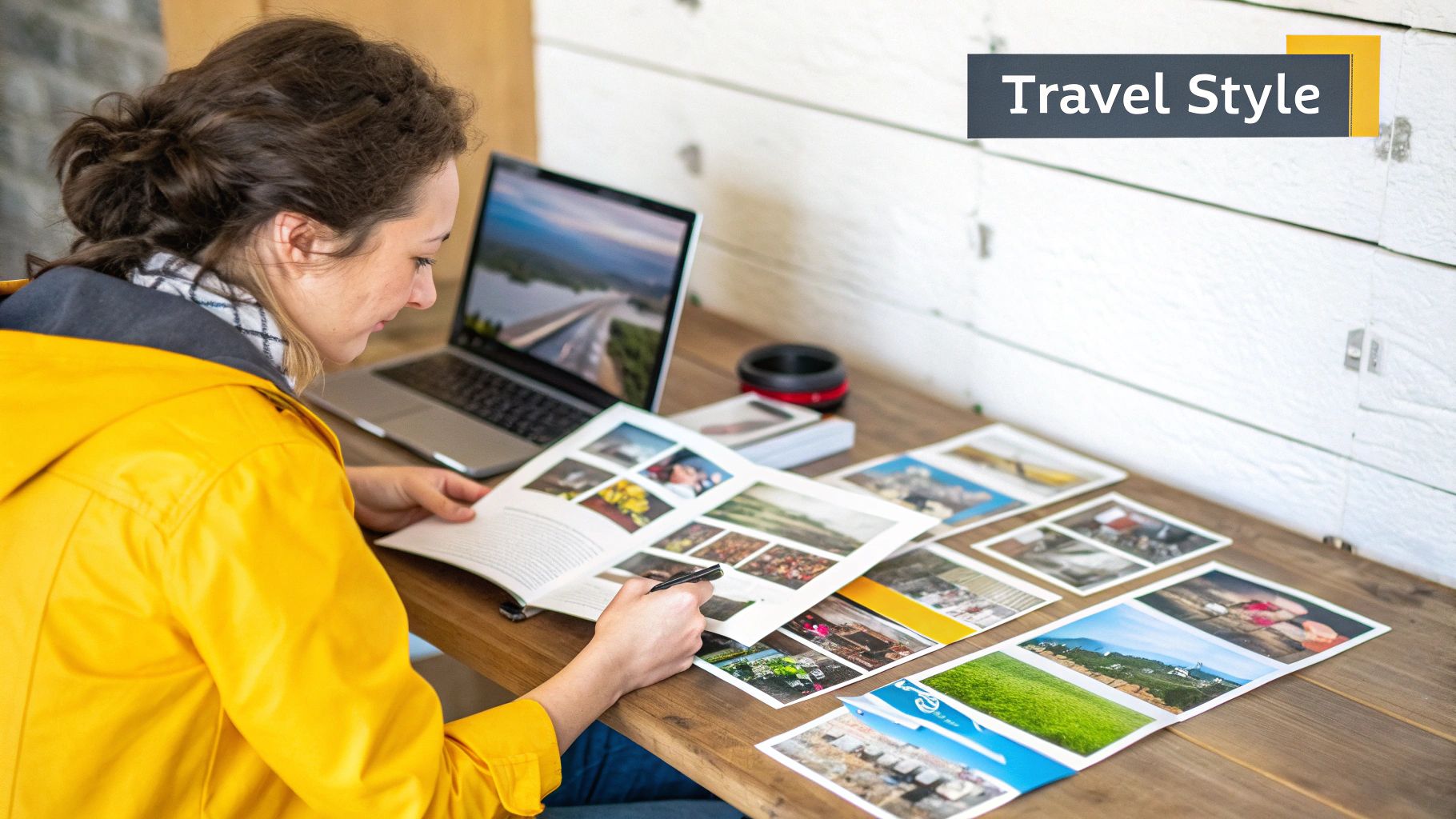
This is where the magic begins. A great road trip isn’t just about booking a car; it's about turning a daydream into a real, tangible plan. Before you even think about looking at a map, the first step is a bit of introspection. You need to get clear on what you really want from this adventure.
What’s the feeling you’re chasing? Maybe it's the thrill of navigating the dramatic, single-track roads of the Scottish Highlands, flask of tea in hand, with a profound sense of splendid isolation. Or perhaps it’s the sun-drenched allure of Cornwall’s coastal paths, with lazy days spent meandering through quaint fishing villages and discovering hidden sandy coves.
You might even be planning a historical pilgrimage, tracing the routes of ancient kings through England's castle-dotted landscapes. Each of these trips demands a completely different plan, from the kind of car you hire to where you lay your head at night.
Define Your Travel Style and Priorities
Think of your travel style as the compass for your entire journey. It's about much more than just picking a spot on the map. It's about understanding the pace, comfort level, and experiences that will make the trip truly yours.
Start by asking yourself a few simple questions:
- What’s the pace? Are you a slow traveller who loves to linger, or do you get a buzz from seeing as much as possible? A classic rookie error is trying to cram too much in. That just leads to exhaustion, not enjoyment.
- What are my non-negotiables? Jot down your top three "must-do" experiences. Is it all about hiking? Hunting for the best local food markets? Discovering brilliant country pubs? Make a list.
- What’s my comfort level? Are you happy with a charmingly rustic farm stay, or do you need the reliable comfort of a well-known hotel chain after a long day behind the wheel?
Answering these questions honestly helps you filter out the noise right from the start. A traveller who thrives on spontaneity and budget-friendly B&Bs will have a completely different itinerary from someone who prefers a touch of luxury and pre-booked tours.
The most memorable road trips are the ones that move at your rhythm. Don't build a trip from someone else's highlight reel; craft one that genuinely brings you joy.
Set a Realistic Budget
With a clearer vision in place, it’s time to talk money. A sensible budget is the bedrock of a stress-free trip, ensuring you’re not worrying about costs when you should be soaking in the views. It needs to be about more than just the big-ticket items.
Think beyond the car and the hotels. You need to account for daily food costs (picnic lunches or three-course pub dinners?), attraction entry fees, parking charges (which can really add up in popular towns), and that all-important contingency fund. I always recommend a safety net of 15-20% of your total budget. It’s a wise buffer for those brilliant but unexpected detours, car niggles, or that one-of-a-kind souvenir you just have to buy.
This kind of careful financial planning is exactly how many UK travellers are thinking these days. In fact, 64% of UK adults now say affordability is their top priority when booking a holiday. It's driving a huge surge in domestic trips to places like Wales, which offers incredible cultural experiences without the price tag of flying abroad. This trend points towards shorter, more budget-savvy UK adventures, and you can get more insights on UK summer travel trends to see how habits are changing.
Choose the Right Time to Travel
Finally, let’s talk timing. It’s everything, especially in the UK where the weather is a national obsession for good reason. Picking your season is usually a trade-off between good weather, fewer crowds, and lower costs.
Here’s a rough guide to help you choose:
- Peak Season (July-August): You can expect the best (though never guaranteed!) weather, but also the biggest crowds, highest prices, and busiest roads. If you travel now, booking everything well in advance is non-negotiable.
- Shoulder Seasons (May-June & September-October): For many, this is the sweet spot. The weather is often lovely, you’ll find fewer tourists, and prices for accommodation and car hire are more competitive. The autumn colours in Scotland or the spring blooms in the Cotswolds are genuinely spectacular.
- Off-Season (November-March): This is perfect for budget-conscious travellers who don’t mind wrapping up warm against the cold and having fewer daylight hours. Some attractions might have limited opening times, but you'll get to see popular spots without the crowds and enjoy a much more local vibe.
Crafting Your Day-by-Day Itinerary

This is where the magic really happens. With your destinations picked and your budget sorted, it’s time to get into the heart of custom travel planning: sketching out the day-to-day flow of your adventure. You're not just creating a schedule; you're building a story, transforming a simple list of places into a logical and enjoyable journey.
The aim isn't a rigid, minute-by-minute plan. It’s about creating a solid framework that guides you but still leaves plenty of room for those spontaneous, unforgettable moments. A well-thought-out itinerary is what separates a frantic dash from a genuine escape. It's all about finding the right rhythm for you.
Mastering Your Route with Digital Tools
First things first, let's get a realistic handle on your route and, crucially, the driving times. While tools like Google Maps or Waze are fantastic starting points, you can't just take their initial time estimates as gospel. Those are almost always based on perfect, traffic-free conditions, which rarely exist in the real world.
This is especially true for a UK self-drive tour. A 100-mile trip down a motorway is a completely different beast to navigating 100 miles of winding A-roads through the Lake District or the single-track lanes you'll find in the Scottish Highlands.
Pro Tip: When you're using a mapping app, try tweaking the settings to "avoid motorways" for parts of your route. This often gives you a more scenic drive and, more importantly, a much more realistic time estimate. As a rule of thumb, always add at least 25-30% to any estimated drive time to account for traffic, photo stops, and those brilliant but unexpected detours.
It's a simple step, but it prevents the classic mistake of underestimating travel time, which is a surefire way to make your holiday feel rushed and stressful.
Balancing Driving with Exploring
One of the biggest pitfalls I see people fall into when planning a road trip is making it all "road" and no "trip." To avoid burnout, you have to be intentional about balancing your driving days with your exploring days. This creates a sustainable pace that keeps you energised from start to finish.
Think about giving your trip a natural rhythm:
- Anchor Days: These are your base camps. Pick a key destination where you might stay for two or even three nights. For instance, you could settle in York for a few days to fully explore the city and the stunning North York Moors nearby.
- Transition Days: These are the days you travel between your anchor points. I always recommend keeping the driving to a maximum of 3-4 hours on these days. This gives you plenty of time for interesting stops along the way without feeling like you're just racing to the next hotel.
- Rest Days: Build in days with little to no driving at all. Use them for a deep dive into a local town, a long hike, or simply to relax and recharge your batteries.
This approach means you're not constantly living out of a suitcase. It provides a sense of stability and lets you properly immerse yourself in a region. To see how this works in practice, have a look at the pacing of this 8-day self-drive tour of England; it’s a great example of how to artfully mix travel days with immersive local stays.
Weaving in Your Points of Interest
Once you've got your route and rhythm down, you can start slotting in all those brilliant attractions and experiences from your initial brainstorm. This is where your detailed research really pays off, allowing you to organise your points of interest logically along your daily route.
Start by layering in your absolute "must-sees." If a visit to Stonehenge is non-negotiable, put it on the map and plan that day's drive and accommodation around it. Then, begin adding your secondary interests—that specific pub you read about, a scenic viewpoint, or a quirky museum.
Finally, and this is key, leave room for serendipity. Here’s a simple structure I use for planning each day:
- The Daily Anchor: Choose one main focus for the day. This could be exploring Conwy Castle, for example.
- The Supporting Stops: Identify two or three smaller, optional stops nearby, like visiting the Smallest House in Great Britain or walking Conwy's town walls.
- The Spontaneous Slot: Keep an afternoon flexible. You might use it to revisit a spot you loved, discover a local artisan's shop you passed, or just find a cosy spot for a cream tea.
This layered approach gives your day purpose without making it rigid. You have a plan you can count on, but also the freedom to ditch it if you stumble upon a hidden beach or an inviting walking trail. This is the essence of a custom self-drive tour—creating a plan strong enough to rely on, but flexible enough to change when a better opportunity comes along. That freedom is what makes it so rewarding.
Securing Your Bookings and Nailing the Logistics

Alright, you've got a brilliant itinerary mapped out. Now comes the exciting part: making it real. This is where we shift from dreaming to doing, turning your planned route into a tangible trip by securing all the necessary bookings. It's the logistical phase where you lock in your accommodation, hire car, and key activities.
Getting this right is what separates a stressful trip from a relaxing one. When you’ve sorted the details, you’re free to enjoy that unexpected viewpoint or linger a little longer in a charming village café. Think of it as the final, crucial layer of preparation before your adventure truly begins.
Choosing and Booking Your Accommodation
The places you stay will define the character of your trip. A UK road trip, thankfully, offers so much more than just standard hotels. One night you could be waking up to a full English breakfast in a cosy B&B, and the next, you might be enjoying the freedom of a self-catering cottage.
Each style has its own charm and practicalities:
- Bed & Breakfasts (B&Bs): These are my top pick for getting a real feel for a place. You get local flavour, insider tips from your hosts, and a hearty breakfast to fuel your day.
- Hotels: They offer reliability and consistency. Perfect for city stops or when you just want the comfort of a good bed and amenities like an on-site restaurant without any fuss.
- Self-Catering Cottages/Apartments: These give you total freedom. Cooking your own meals is a great way to manage your budget, and you can really settle in and feel like a local.
- Country Pubs with Rooms: The ultimate in convenience and character. There's nothing quite like finishing a day's drive and heading downstairs for a proper pub dinner and a pint.
My Advice: Don't stick to just one type. Mix and match. A few nights in a friendly B&B followed by a self-catering stay gives you the best of both worlds—local interaction and complete independence. It adds a wonderful variety to the journey.
A quick word of warning: book well in advance, especially if you're travelling to hotspots like the Cotswolds or the Scottish Highlands during peak season. Securing your accommodation early prevents disappointment and often means better prices.
Hiring the Right Vehicle for Your Journey
Your car is more than just transport on a road trip; it's your base, your luggage carrier, and your ticket to freedom. Choosing the right one is vital. I’ve learned from experience that a nimble, smaller car is a godsend for navigating the narrow country lanes in Cornwall. On the other hand, if you're tackling long motorway drives up to Scotland with a family's worth of luggage, you’ll be grateful for the space and comfort of a larger vehicle.
When you're comparing car hire options, look past the headline daily rate.
- Mileage Policy: Always go for unlimited mileage. A multi-day tour racks up the miles faster than you think, and you don’t want a nasty surprise bill at the end.
- Insurance: Check what the basic insurance really covers. I always recommend paying a little extra for excess reduction insurance. It gives you complete peace of mind, knowing a small scratch won't turn into a costly drama.
- Fuel Policy: A "full-to-full" policy is almost always the most straightforward and cost-effective option. You pick the car up with a full tank and return it the same way.
The entire travel booking world has moved online, and it's a trend that's here to stay. In the UK, gross travel bookings recently hit a massive £53.5 billion. A staggering 88% of those were made online, a figure projected to climb to 90% by 2027. It's clear that getting comfortable with digital booking platforms is key.
Pre-Booking Activities and Final Checks
For those big-ticket items—think the Warner Bros. Studio Tour London or a timed slot for Edinburgh Castle—booking ahead isn't just a good idea; it's non-negotiable. If you don't, you'll likely miss out. Nailing this part of your custom travel planning means your "must-do" experiences are guaranteed.
Here’s a final tip: create a simple spreadsheet or use a travel app to keep all your confirmations and booking numbers in one place. Organising your logistics like this means that once you hit the road, your only job is to enjoy the adventure. If you're looking for a blueprint, browsing some professionally arranged self-drive tours can give you a fantastic model for your own plan.
Getting Road-Ready and Navigating Your Trip
Alright, this is the final stretch. Your brilliant plan is about to meet the real world. Think of this stage as building your safety net, turning a great itinerary into a seamless adventure on the ground. A bit of focused effort now is what separates a stressful trip from a fantastic one.
Getting these last pieces sorted means that when you finally slide behind the wheel, you can stop being a planner and start being an explorer. You've done the hard work; now it's time to enjoy it.
What to Pack for a UK Road Trip
Packing for a UK road trip is a unique challenge. You're not packing for the weather you want; you're packing for the weather you're going to get – which can often be all four seasons in a single afternoon. This is especially true if you’re heading to the mountains of Wales or the Scottish Highlands.
Layering is your best friend. A solid waterproof jacket is absolutely non-negotiable, even if the forecast promises sunshine. Trust me on this one. You’ll also want a pair of sturdy, comfortable shoes you’ve already broken in. You’ll be glad you have them, whether you’re navigating the cobbled lanes of a historic city or a muddy path to a standing stone.
Beyond the basics, it’s the little things that really elevate a road trip:
- A reusable water bottle and a good thermos. Perfect for staying hydrated and for that essential cup of tea or coffee when you find a stunning viewpoint with no café in sight.
- A portable power bank. Your phone is your navigator, camera, and guidebook all in one. Keeping it charged is crucial, particularly when you’re out exploring rural areas for hours at a time.
- A small first-aid kit. Pack the essentials: plasters, pain relief, antiseptic wipes, and of course, any personal medications you need.
- Car snacks. Cereal bars, nuts, and other non-perishables are a godsend when hunger strikes miles from the nearest village shop.
Your car becomes your mobile base camp. The goal isn't just to pack your bags, but to set up your vehicle so it's comfortable, organised, and ready for whatever spontaneous detours come your way.
Organising Your Documents: Digital and Physical
In a world of apps and e-tickets, having both physical and digital copies of your documents might seem old-fashioned, but it's a game-changer for peace of mind. A phone battery can die. A printed confirmation can get lost. Having a backup for your backup is the simplest way to sidestep travel stress.
Get yourself a simple plastic wallet or folder for the physical stuff. This is where you’ll keep printed copies of:
- Hotel and B&B booking confirmations
- Car hire agreement and insurance papers
- Any flight or train tickets
- Tickets for pre-booked attractions or tours
- A photocopy of your driving licence and passport
For the digital side, create a dedicated folder in a cloud service like Google Drive or Dropbox. Save PDF versions of everything listed above. This gives you access from any device with an internet connection. But here’s the pro tip: download offline versions of these files directly to your phone. That way, you can pull up a booking reference even when you’re in a mobile signal black spot.
Mastering Navigation on the Go
Your hire car’s sat-nav is fine, but your smartphone is your secret weapon. Apps like Google Maps or Waze offer live traffic updates, which are invaluable for dodging the inevitable jams on the M25 or around cities like Manchester or Bristol.
But if you remember only one thing from this section, make it this: download offline maps for your entire route before you leave. Mobile signal in the UK's most beautiful spots—the Scottish Highlands, the Yorkshire Dales, the depths of Cornwall—is notoriously unreliable. An offline map works perfectly without a connection and will save you from taking a very wrong, very stressful turn.
Go beyond just following the blue line. Before you even set off, use your mapping app to "pin" or "save" every key location. Drop a pin for each hotel, car park, and must-see viewpoint. This creates a visual skeleton of your day, making it incredibly easy to see where you're going and adapt if you need to.
Handling Spontaneous Changes and Troubleshooting
No plan is perfect. The famously unpredictable British weather might scupper your coastal walk, or a surprise road closure could block your path to that quaint village you were excited about. A great road trip isn't defined by a flawless itinerary, but by how you handle these little curveballs.
When things don’t go to plan, just take a breath. A quick look at a weather app might show the rain is only a passing shower. Your mapping app will almost certainly find you a clever detour around that closed road—and these detours are often where the best, most unexpected discoveries happen.
This is also where your backup research comes in handy. If your main attraction is unexpectedly shut, pull up your notes and see what other gems you marked nearby. Learning to embrace these moments is what turns a potential hiccup into a memorable part of your story. After all, isn’t the freedom to change course the whole point of a self-drive adventure?
Your Top Custom Travel Planning Questions Answered
When you start digging into the details of a self-drive holiday, a few key questions always seem to surface. It’s completely normal. Nailing down the answers to these common queries is what turns a good plan into a great one, helping you sidestep potential headaches before you’ve even packed your bags.
Let's clear up some of the most frequent sticking points. Think of this as the final check, making sure you feel ready and excited for the adventure ahead.
How Much Should I Really Budget Per Day?
This is the big one, isn't it? The honest answer is: it completely depends on how you like to travel. A daily budget for a UK road trip can swing quite dramatically.
If you're watching your pennies, you can absolutely have a fantastic time on £75-£100 a day. This would mean bunking down in quality hostels or cheerful, budget-friendly B&Bs, grabbing lunch from local bakeries for a scenic picnic, and focusing on the UK's incredible free attractions – think stunning coastal hikes and exploring vast national parks.
For those who fancy a bit more comfort, a mid-range budget of £150-£250+ per person per day is a more realistic figure. This opens the door to charming hotels, a proper pub lunch every day, and entry fees to those iconic castles and historic sites you've been dreaming of.
Don't forget the car! I always tell people to set aside an extra £40-£60 per day just for fuel and the hire car itself. The exact amount will depend on how much driving you're doing and what kind of car you've chosen. And my best piece of advice? Always add a 15% contingency fund. It’s for those brilliant, unexpected moments, like a last-minute boat trip or a souvenir you just have to buy.
What's The Biggest Mistake I Can Make When Planning?
From my experience, the single most common pitfall is trying to do too much. It’s so easy to get carried away, cramming your map with pins and your schedule with back-to-back activities. But this almost always leads to burnout, leaving you feeling like you're just racing from one place to the next.
The reality of driving in the UK, especially on those gorgeous but narrow country lanes, is that it takes longer than you think. A 50-mile trip on paper can easily stretch to two hours once you factor in a few stops for photos or a surprise village fete. The real magic happens when you slow down. Build breathing room into your itinerary. Give yourself the freedom to linger over a coffee in a town you've fallen for instead of dashing off to the next checkbox on your list.
Should I Book All My Accommodation in Advance?
For this, I’m a firm believer in a hybrid approach. You want the security of having key nights locked in, but the flexibility to embrace a bit of spontaneity.
-
When to Absolutely Book Ahead:
- Peak Season: If you're heading to hotspots like Cornwall, the Lake District, or the Scottish Highlands between June and August (or on any bank holiday!), book your accommodation months in advance. Seriously.
- Crucial Nights: Always book your first and last nights. It takes all the stress out of arriving late or having an early flight to catch.
- The "Must-Stays": Have you found a specific B&B with rave reviews or a quirky cottage you can't stop thinking about? Lock it in the moment your dates are confirmed.
-
When You Can Be More Spontaneous:
- Off-Season: Travelling between November and March? You’ll find you have much more freedom to find great last-minute spots.
- Off the Beaten Track: If your route ventures away from the main tourist trails, you can often get away with booking just a day or two in advance as you travel.
This balanced strategy gives you a solid framework for your trip, but still leaves room for those happy accidents and spontaneous detours that make a road trip so memorable.
Ready to turn your dream road trip into a reality without the planning stress? The expert team at BTOURS crafts personalised self-drive tours across the UK, handling all the logistics so you can focus on the adventure. Explore our curated itineraries at https://www.btours.com.

